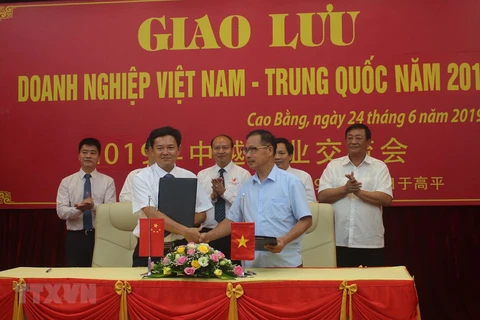 Vice Chairman of the Hanoi People’s Committee Nguyen Manh Quyen (R) and Mayor of Shenzhen Qin Weizhong. (Photo: hanoimoi.com.vn)
Vice Chairman of the Hanoi People’s Committee Nguyen Manh Quyen (R) and Mayor of Shenzhen Qin Weizhong. (Photo: hanoimoi.com.vn) Hanoi (VNA) – Shenzhen city of China wishes to further promote economic and trade relations with Vietnamese localities, including the capital city of Hanoi, especially in investment, 5G technology, new energy vehicles (NEV), wind power, and renewable energy, said Mayor of Shenzhen Qin Weizhong.
During a meeting with Vice Chairman of the Hanoi People’s Committee Nguyen Manh Quyen in Hanoi on September 18, Qin, who is also Deputy Secretary of the Shenzhen Municipal Party Committee, briefed the host on the Chinese city’s development.
Shenzhen's GDP reached 500 billion USD in 2022, while its industrial production topped localities across China. Shenzhen has also witnessed the formation and development of big high-tech enterprises, such as Huawei, Tencent, and BYD automobile companies. It is also the headquarters of 11 firms in the global Top 500.
Vietnam is the largest trading partner of Shenzhen within ASEAN, and the cooperative relationship between the two sides is on a trajectory of growth and development, Qin stressed.
For his part, Quyen expressed an impression of Shenzhen’s development, noting there are many favourable conditions for further stepping up friendship and cooperation in various fields between Vietnam and China, as well as their localities.
With its annual gross regional domestic product (GRDP) growth rate ranging from 7-8%, Hanoi possesses huge potential and room for stronger development, Quyen stressed, adding that the capital city has planned to develop satellite urban areas.
Hanoi has also substantial potential for high-tech agriculture development as it boasts a large agricultural land area, he added.
Hanoi is accelerating the construction of ring road projects, and urban metro lines, including Cat Linh - Ha Dong route, which has collaborated with China, Quyen said.
The host mentioned difficulties related to infrastructure, the environment, and transport facing the capital city, stressing that Hanoi wants to attract investors in high and clean technology, and infrastructure development that connects central areas and satellite urban areas.
Quyen suggested the two localities consider the possibility of promoting long-term development cooperation programmes to maximise each other's advantages, expressing a belief that with Shenzhen's potential and strengths, the two sides can completely expand partnership for mutual development in the coming time.
The two officials also discussed potential cooperation aspects, including Hoa Lac Hi-Tech Park, urban metro lines, and construction of one more airport in Hanoi, and shifting from fossil fuels to clean energy for public transport.
Qin stated that Shenzhen businesses are capable of supporting Hanoi from planning to construction, operation, and management in these areas./.

























